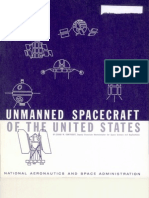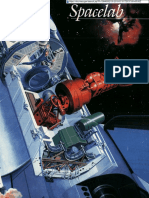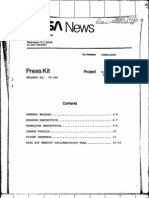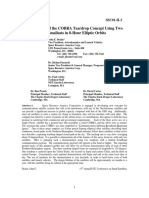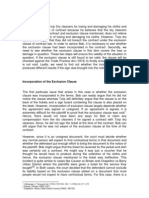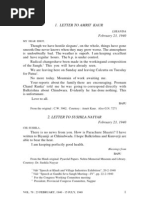Spitzer Space Telescope
Spitzer Space Telescope
Uploaded by
David DoakCopyright:
Available Formats
Spitzer Space Telescope
Spitzer Space Telescope
Uploaded by
David DoakCopyright
Available Formats
Share this document
Did you find this document useful?
Is this content inappropriate?
Copyright:
Available Formats
Spitzer Space Telescope
Spitzer Space Telescope
Uploaded by
David DoakCopyright:
Available Formats
Spitzer Space Telescope -From Wikipedia, the free encyclopedia
The Spitzer Space Telescope prior to launch
General information NSSDC ID 2003-038A Org NASA / JPL / Caltech Major contractors Lockheed Martin Ball Aerospace Launch date 2003-08-25, 05:35:00 UTC Launched from Cape Canaveral, Florida Launch vehicle Delta II 7920H ELV Mission length 2.5 to 5+ years (8 years, 7 months and 5 days elapsed) Mass 950 kg (2,100 lb) Type of orbit Heliocentric Orbit period 1 year Orbiting the Sun Telescope style-Ritchey-Chrtien, Wavelength 3 to 180 meters, Dia-0.85 m (2 ft 9 in) Focal length 10.2 m Instruments--IRAC infrared camera, IRS infrared spectrometer, MIPS far infrared detector arrays Website-www.spitzer.caltech.edu/ The Spitzer Space Telescope (SST), formerly the Space Infrared Telescope Facility (SIRTF) is an infrared space observatory launched in 2003. It is the fourth and final of the NASA Great Observatories program. The planned mission period was to be 2.5 years with a pre-launch expectation that the mission could extend to five or slightly more years until the onboard liquid helium supply was exhausted. This occurred on 15 May 2009.[3] Without liquid helium to cool the telescope to the very cold temperatures needed to operate, most instruments are no longer usable. However, the two shortest wavelength modules of the IRAC camera are still operable with the same sensitivity as before the cryogen was exhausted, and will continue to be used in the Spitzer Warm Mission.[4] In keeping with NASA tradition, the telescope was renamed after successful demonstration of operation, on December 18, 2003. Unlike most telescopes which are named after famous deceased astronomers by a board of scientists, the name for SIRTF was obtained from a contest open to the general public. The contest led to the telescope being named in honor of Lyman Spitzer, one of the 20th century's great scientists.[5] Though he was not the first to propose the idea of the space telescope (Hermann Oberth being the first, in Wege zur Raumschiffahrt, 1929,[6] and also in Die Rakete zu den Planetenrumen, 1923),[7] Spitzer wrote a 1946 report for RAND describing the advantages of an extraterrestrial observatory and how it could be realized with available (or upcoming) technology.[8][9] He has been cited for his pioneering contributions to rocketry and astronomy, as well as "his vision and leadership in articulating the advantages and benefits to be realized from the Space Telescope Program."[5] The US$800 million Spitzer was launched from Cape Canaveral Air Force Station, on a Delta II 7920H ELV rocket, Monday, 25 August 2003 at 13:35:39 UTC-5 (EDT).[10] It follows a rather unusual orbit, heliocentric instead of geocentric, trailing and drifting away from Earth's orbit at approximately 0.1 astronomical unit per year (a so-called "earth-trailing" orbit). The primary mirror is 85 centimetres (33 in) in diameter, f/12 and made of beryllium and was cooled to 5.5 K (449.77 F). The satellite contains three instruments that allowed it to perform astronomical imaging and photometry from 3 to 180 micrometers, spectroscopy from 5 to 40 micrometers, and spectrophotometry from 5 to 100 micrometers. History By the early 1970s, astronomers began to consider the possibility of placing an infrared telescope above the obscuring effects of Earth's atmosphere. In 1979, a National Research Council of the National Academy of Sciences report, A Strategy for Space Astronomy and Astrophysics for the 1980s, identified a Space Infrared Telescope Facility (SIRTF) as "one of two major astrophysics facilities [to be developed] for Spacelab", a Shuttle-borne platform. Anticipating the major results from an upcoming Explorer satellite and from the Shuttle mission, the report also favored the "study and development of ... long-duration spaceflights of infrared telescopes cooled to cryogenic temperatures." The launch in January 1983 of the Infrared Astronomical Satellite, jointly developed by
the United States, the Netherlands, and the United Kingdom, to conduct the first infrared survey of the sky, whetted the appetites of scientists worldwide for follow-up space missions capitalizing on the rapid improvements in infrared detector technology. Earlier infrared observations had been made by both space-based and ground-based observatories. Ground-based observatories have the drawback that at infrared wavelengths or frequencies, both the Earth's atmosphere and the telescope itself will radiate (glow) strongly. Additionally, the atmosphere is opaque at most infrared wavelengths. This necessitates lengthy exposure times and greatly decreases the ability to detect faint objects. It could be compared to trying to observe the stars at noon. Previous space-based satellites (such as IRAS, the Infrared Astronomical Satellite, and ISO, the Infrared Space Observatory) were operational during the 1980s and 1990s and great advances in astronomical technology have been made since then. Most of the early concepts envisioned repeated flights aboard the NASA Space Shuttle. This approach was developed in an era when the Shuttle program was expected to support weekly flights of up to 30 days duration. A May 1983 NASA proposal described SIRTF as a Shuttle-attached mission, with an evolving scientific instrument payload. Several flights were anticipated with a probable transition into a more extended mode of operation, possibly in association with a future space platform or space station. SIRTF would be a 1-meter class, cryogenically cooled, multi-user facility consisting of a telescope and associated focal plane instruments. It would be launched on the Space Shuttle and remain attached to the Shuttle as a Spacelab payload during astronomical observations, after which it would be returned to Earth for refurbishment prior to re-flight. The first flight was expected to occur about 1990, with the succeeding flights anticipated beginning approximately one year later. However, the Spacelab-2 flight aboard STS-51-F showed that the Shuttle environment was poorly suited to an onboard infrared telescope due to contamination from the relatively "dirty" vacuum associated with the orbiters. By September 1983 NASA was considering the "possibility of a long duration [free-flyer] SIRTF mission".[11][12] Spitzer is the only one of the Great Observatories not launched by the Space Shuttle, which had been originally intended. However after the 1986 Challenger disaster, the Centaur LH2/LOX upper stage, which would have been required to place it in its final orbit, was banned from Shuttle use. The mission underwent a series of redesigns during the 1990s, primarily due to budget considerations. This resulted in a much smaller but still fully capable mission which could use the smaller Delta II expendable launch vehicle. One of the most important advances of this redesign was an Earth-trailing orbit. Cryogenic satellites that require liquid helium (LHe, T 4 K) temperatures in near-Earth orbit are typically exposed to a large heat load from the Earth, and consequently entail large usage of LHe coolant, which then tends to dominate the total payload mass and limits mission life. Placing the satellite in solar orbit far from Earth allowed innovative passive cooling such as the sun shield, against the single remaining major heat source to drastically reduce the total mass of helium needed, resulting in an overall smaller lighter payload, with major cost savings. This orbit also simplifies telescope pointing, but does require the Deep Space Network for communications. The primary instrument package (telescope and cryogenic chamber) was developed by Ball Aerospace & Technologies Corp., in Boulder, CO. The individual instruments were developed jointly by industrial, academic, and government institutions, the principals being Cornell, the University of Arizona, the Smithsonian Astrophysical Observatory, Ball Aerospace, and Goddard Spaceflight Center. The infrared detectors were developed by Raytheon in Goleta, California. Raytheon used indium antimonide and a doped silicon detector in the creation of the infrared detectors. It is stated that these detectors are 100 times more sensitive than what was once available in the beginning of the project during the 1980's[13]. The spacecraft was built by Lockheed Martin. The mission is operated and managed by the Jet Propulsion Laboratory and the Spitzer Science Center,[14] located on the Caltech campus in Pasadena, CA Instruments Spitzer carries three instruments on-board:[15][16][17][18] IRAC (Infrared Array Camera), an infrared camera which operates simultaneously on four wavelengths (3.6 m, 4.5 m, 5.8 m and 8 m). Each module uses a 256 256 pixel detectorthe short wavelength pair use indium antimonide technology, the long wavelength pair use arsenic-doped silicon impurity band conduction technology.[19] The two shorter wavelength bands (3.6 m & 4.5 m) for this instrument remain productive after LHe depletion in the spring of 2009, at the telescope equilibrium temperature of around 30 K, so IRAC continues to operate as the "Spitzer Warm Mission". IRS (Infrared Spectrograph), an infrared spectrometer with four sub-modules which operate at the wavelengths 5.3-14 m (low resolution), 10-19.5 m (high resolution), 14-40 m (low resolution), and 19-37 m (high resolution). Each module uses a 128x128 pixel detectorthe short wavelength pair use arsenic-doped silicon blocked impurity band technology, the long wavelength pair use antimony-doped silicon blocked impurity band technology.[20] MIPS (Multiband Imaging Photometer for Spitzer), three detector arrays in the far infrared (128 128 pixels at 24 m, 32 32 pixels at 70 m, 2 20 pixels at 160 m). The 24 m detector is identical to one of the IRS short wavelength modules. The
70 m detector uses gallium-doped germanium technology, and the 160 m detector also uses gallium-doped germanium, but with mechanical stress added to each pixel to lower the bandgap and extend sensitivity to this long wavelength.[21] An ex of data from the diff instruments, the nebula Henize 206 was imaged, allowing comparison of images from each device. Results
The Helix Nebula. Blue shows infrared light of 3.6 to 4.5 micrometers; green shows infrared light of 5.8 to 8 micrometers; and red shows infrared light of 24 micrometers.
The Andromeda Galaxy (M31) taken by Spitzer in infrared, MIPS, 24 micrometers
The first images taken by SST were designed to show off the abilities of the telescope and showed a glowing stellar nursery; a big swirling, dusty galaxy; a disc of planet-forming debris; and organic material in the distant universe. Since then, many monthly press releases have highlighted Spitzer's capabilities, as the NASA and ESA images do for the Hubble Space Telescope. SST became the first telescope to directly capture the light from extrasolar planets, namely the "hot Jupiters" HD 209458b and TrES-1. (It did not resolve that light into actual images though.)[22] This was the first time extrasolar planets had actually been visually seen; earlier observations had been indirectly made by drawing conclusions from behaviors of the stars the planets were orbiting. The telescope also discovered in April 2005 that Cohen-kuhi Tau/4 had a planetary disk that was vastly younger and contained less mass than previously theorized, leading to new understandings of how planets are formed.
Clockwise from the upper-left: infrared views of spiral galaxy Messier 81; embedded outflows from Herbig-Haro 46/47 protostar; protostars uncovered in multiple views of dark globule in IC1396; and Comet Schwassmann-Wachmann 1. While some time on the telescope is reserved for participating institutions and crucial projects, astronomers around the world also have the opportunity to submit proposals for observing time. Important targets include forming stars (young stellar objects, or YSOs), planets, and other galaxies. Images are freely available for educational and journalistic purposes. In 2004, it was reported that Spitzer had spotted a faintly glowing body that may be the youngest star ever seen. The telescope was trained on a core of gas and dust known as L1014 which had previously appeared completely dark to ground-based observatories and to ISO (Infrared Space Observatory), a predecessor to Spitzer. The advanced technology of Spitzer revealed a bright red hot spot in the middle of L1014. Scientists from the University of Texas at Austin, who discovered the object, believe the hot spot to be an example of early star development, with the young star collecting gas and dust from the cloud around it. Early speculation about the hot spot was that it might
have been the faint light of another core that lies 10 times further from Earth but along the same line of sight as L1014. Follow-up observation from ground-based near-infrared observatories detected a faint fan-shaped glow in the same location as the object found by Spitzer. That glow is too feeble to have come from the more distant core, leading to the conclusion that the object is located within L1014. (Young et al., 2004) In 2005, astronomers from the University of Wisconsin at Madison and Whitewater determined, on the basis of 400 hours of observation on the Spitzer Space Telescope, that the Milky Way Galaxy has a more substantial bar structure across its core than previously recognized.
Artificial color image of the Double Helix Nebula, thought to be generated at the galactic center by magnetic torsion 1000 times greater than the sun's.
Also in 2005, astronomers Alexander Kashlinsky and John Mather of NASA's Goddard Space Flight Center reported that one of Spitzer's earliest images may have captured the light of the first stars in the universe. An image of a quasar in the Draco constellation, intended only to help calibrate the telescope, was found to contain an infrared glow after the light of known objects was removed. Kashlinsky and Mather are convinced that the numerous blobs in this glow are the light of stars that formed as early as 100 million years after the big bang, red shifted by cosmic expansion.[23] In March 2006, astronomers reported an 80-light-year-long nebula near the center of the Milky Way Galaxy, the Double Helix Nebula, which is, as the name implies, twisted into a double spiral shape. This is thought to be evidence of massive magnetic fields generated by the gas disc orbiting the supermassive black hole at the galaxy's center, 300 light years from the nebula and 25,000 light years from Earth. This nebula was discovered by the Spitzer Space Telescope, and published in the magazine Nature on March 16, 2006. In May 2007, astronomers successfully mapped the atmospheric temperature of HD 189733 b, thus obtaining the first map of some kind of an extrasolar planet.
A cluster of new stars forming in the Serpens South cloud
Since September 2006 the telescope participates in a series of surveys called the Gould Belt Survey, observing the Gould's Belt region in multiple wavelengths. The first set of observations by the Spitzer Space Telescope were completed from September 21, 2006 through September 27. Resulting from these observations, the team of astronomers led by Dr. Robert Gutermuth, of the HarvardSmithsonian Center for Astrophysics reported the discovery of Serpens South, a cluster of 50 young stars in the Serpens constellation. In August 2009, the telescope found evidence of a high-speed collision between two burgeoning planets orbiting a young star.[24] In October 2009, astronomers published findings of the "Phoebe ring" of Saturn, which was found w/w the telescope; the ring is a huge, tenuous disc of material extending from 128 to 207 times the radius of Saturn.[25] GLIMPSE and MIPSGAL surveys
GLIMPSE, the Galactic Legacy Infrared Mid-Plane Survey Extraordinaire, is a survey spanning 300 of the inner Milky Way galaxy. It consists of approximately 444,000 images taken at 4 separate wavelengths using the Infrared Array Camera.[26] MIPSGAL is a similar survey covering 278 of the galactic disk at longer wavelengths. On June 3, 2008, scientists unveiled the largest, most detailed infra-red portrait of the Milky Way, created by stitching together more than 800,000 snapshots, at the 212th meeting of the American Astronomical Society in St.Louis, Missouri.[27][28] This composite survey is now viewable with the GLIMPSE/MIPSGAL Viewer. See also -Infrared astronomy Zooniverse - The Milky Way Project References 1. ^ Spitzer Space Telescope (2008). "About Spitzer: Fast Facts". NASA / JPL. Archived from the original on 2007-02-02. 2. 3. 4. 5. 6. 7. 8. 9.
http://web.archive.org/web/20070202210921/http://www.spitzer.caltech.edu/about/fastfacts.shtml. Retrieved 2007-04-22. ^ Spitzer Space Telescope. "Spitzer Technology: Telescope". NASA / JPL. Archived from the original on 2007-02-24. http://web.archive.org/web/20070224041211/http://www.spitzer.caltech.edu/technology/telescope.shtml. Retrieved 2007-04-22. ^ http://www.spitzer.caltech.edu/Media/releases/ssc2009-12/index.shtml ^ Spitzer Science Center. "Cycle-6 Warm Mission". NASA / JPL. http://sohelp2.ipac.caltech.edu/support/index.php? _m=knowledgebase&_a=view&parentcategoryid=8&nav=0. Retrieved 2009-09-16. ^ a b "Who was Lyman Spitzer?". Nasa: For Educators. California Institute of Technology and the Jet Propulsion Laboratory. 11 March 2004. http://www.nasa.gov/audience/foreducators/postsecondary/features/F_Lyman_Spitzer.html. Retrieved 6 January 2009. ^ "Up close and personal". Physics World (Institute of Physics). 2 March 2009. http://physicsworld.com/cws/article/print/37981. Retrieved 20 April 2009. ^ Please refer to Hubble Space Telescope. ^ Hubble vision: further adventures with the Hubble Space Telescope. CUP Archive. 1998. p. 193. ISBN 0-521-59291-7. ^ Zimmerman, Robert (2008). The universe in a mirror: the saga of the Hubble Telescope and the visionaries who built it. Princeton University Press. p. 10. ISBN 0-691-13297-6. http://www.spaceflightnow.com/news/n0312/17sstresults/. Retrieved 2008-08-23. Retrieved 2007-12-08.
10. ^ William Harwood (December 18, 2003). "First images from Spitzer Space Telescope unveiled". Spaceflight Now.
11. ^ Watanabe, Susan (2007-11-22). "Studying the Universe in Infrared". NASA. http://www.nasa.gov/mission_pages/spitzer/infrared/index.html. 12. ^ Kwok, Johnny (Fall 2006). "Finding a Way: The Spitzer Space Telescope Story". Academy Sharing Knowledge. NASA. Archived from the original on 13. 14. 15. 16. 17. 18. 19. 20. 21. 22. 23. 24. 25.
2007-09-08. http://web.archive.org/web/20070908000438/http://appel.nasa.gov/ask/issues/25/25s_finding.php. Retrieved 2007-12-09. ^ http://investor.raytheon.com/phoenix.zhtml?c=84193&p=irol-newsArticle_Print&ID=483065&highlight= ^ Spitzer Science Center Home Page -- Public information. ^ SSC Observatory general information page, 4 Oct 2009. ^ SSC Observatory Overview, 4 Oct 2009. ^ SSC Science Information home page, 4 Oct 2009. ^ Spitzer Observers' Manual, reference for technical instrument information, Ver 8, 15 Aug 2008. ^ SSC IRAC (Mid IR camera) science users information page, 4 Oct 2009. ^ SSC IRS (spectrometer) science users' information page, 4 Oct 2009. ^ SSC MIPS (long wavelength 24um, 70um, & 160um) imaging photometer and spectrometer science users' information page, 4 Oct 2009. ^ Press Release: NASA's Spitzer Marks Beginning of New Age of Planetary Science. ^ Infrared Glow of First Stars Found: Scientific American. ^ BBC NEWS | Science & Environment | Traces of planet collision found ^ Verbiscer, Anne; Michael Skrutskie, Douglas Hamilton (published online October 7, 2009). "Saturns largest ring". Nature 461 (7267): 1098100. Bibcode 2009Natur.461.1098V. doi:10.1038/nature08515. PMID 19812546. http://www.nature.com/nature/journal/vaop/ncurrent/pdf/nature08515.pdf.
26. ^ Galactic Legacy Infrared Mid-Plane Survey Extraordinaire, University of WisconsinMadison Department of Astronomy 27. ^ Press Release: Spitzer Captures Stellar Coming of Age in Our Galaxy 28. ^ Released Images and Videos of Milky Way Mosaic External links Wikimedia Commons has media related to: Spitzer space telescope
Spitzer Space Telescope official site
Spitzer Space Telescope Profile by NASA's Solar System Exploration Spitzer images Spitzer newsroom Spitzer podcasts Spitzer video podcasts Simulation of Spitzer's orbit Zoomable version of the GLIMPSE/MIPSGAL surveys
Retrieved from "http://en.wikipedia.org/w/index.php?title=Spitzer_Space_Telescope&oldid=483942514" --Categories: -Space telescopes Infrared telescopes Lockheed Martin satellites and probes Artificial satellites orbiting the Sun Astronomical imaging Infrared imaging Spitzer Space Telescope Spacecraft launched by Delta II rockets 2003 in spaceflight Spaceflights Toolbox-What links here Related changes Special pages Create a book Download as PDF
You might also like
- Louise Edington - The Complete Guide To Astrology - Understanding Yourself, Your Signs, and Your Birth Chart-Rockridge Press (2020)Document172 pagesLouise Edington - The Complete Guide To Astrology - Understanding Yourself, Your Signs, and Your Birth Chart-Rockridge Press (2020)JohhnFrank100% (28)
- 2002 - NASA - Solar Probe - An Engineering StudyDocument88 pages2002 - NASA - Solar Probe - An Engineering StudymarkessNo ratings yet
- Launching Vehicles & SatellitesDocument34 pagesLaunching Vehicles & Satelliteshussymical12343% (7)
- STC Building - Raj RewalDocument1 pageSTC Building - Raj RewalNidhi67% (3)
- BSC in Financial ServicesDocument16 pagesBSC in Financial ServicesBobby IM SibaraniNo ratings yet
- Astronomy ResearchDocument7 pagesAstronomy ResearchNick UrsarescuNo ratings yet
- EnglishDocument3 pagesEnglishЛёха СмирновNo ratings yet
- Limits Cards: We Have 60+ NASA - Gov 6/11Document25 pagesLimits Cards: We Have 60+ NASA - Gov 6/11Joel LeeNo ratings yet
- Essay On Indian Space Research OrganisationDocument4 pagesEssay On Indian Space Research OrganisationVivek Bhardwaj100% (1)
- James Webb Space TelescopeDocument15 pagesJames Webb Space TelescopeArpit KumarNo ratings yet
- Libro - Sounding - Rockets - HistoryDocument199 pagesLibro - Sounding - Rockets - HistoryanibalNo ratings yet
- Radars For Ballistic Missile Defense Research: Philip A. Ingwersen and William Z. LemniosDocument22 pagesRadars For Ballistic Missile Defense Research: Philip A. Ingwersen and William Z. LemniosEleanor BirdNo ratings yet
- A Review On Different Satellite ProgramsDocument35 pagesA Review On Different Satellite Programsmilas12345100% (1)
- Telescope Research: Left: Artist's Rendering of SST Right: Diagram of SST's Parts, Courtesy of NASADocument2 pagesTelescope Research: Left: Artist's Rendering of SST Right: Diagram of SST's Parts, Courtesy of NASAmimiNo ratings yet
- Essay On ISRODocument4 pagesEssay On ISROVivek BhardwajNo ratings yet
- Space Shuttle Mission STS-46Document59 pagesSpace Shuttle Mission STS-46Aviation/Space History LibraryNo ratings yet
- IRAS Press KitDocument35 pagesIRAS Press KitBob AndrepontNo ratings yet
- Skylab 4 MissionDocument38 pagesSkylab 4 MissionAviation/Space History LibraryNo ratings yet
- Evolution of Satellite Meteorology: 1.1 Before SatellitesDocument15 pagesEvolution of Satellite Meteorology: 1.1 Before SatellitesSam LawrenceNo ratings yet
- Abstract. The James Webb Space Telescope (JWST) Is A Large (6.6 M), Cold (Document122 pagesAbstract. The James Webb Space Telescope (JWST) Is A Large (6.6 M), Cold (pumpkinpewterNo ratings yet
- NRL Spectra - Fall 2011Document36 pagesNRL Spectra - Fall 2011U.S. Naval Research LaboratoryNo ratings yet
- Science and TechnologyDocument10 pagesScience and TechnologyRavinder SinghNo ratings yet
- Hubble Space TelescopeDocument2 pagesHubble Space TelescopeYadbir SinghNo ratings yet
- News Notes: Edited by Joshua RothDocument5 pagesNews Notes: Edited by Joshua RothbirbiburbiNo ratings yet
- Behind The Scenes of SOFIADocument6 pagesBehind The Scenes of SOFIANick HowesNo ratings yet
- 202004261258144679arun Dwivedi Geog Remote SensingDocument8 pages202004261258144679arun Dwivedi Geog Remote SensingImthiyas ShajiNo ratings yet
- Mariner 4: Jump To Navigation Jump To SearchDocument9 pagesMariner 4: Jump To Navigation Jump To SearchJaneeshVargheseNo ratings yet
- Infrared Space Observatory - IsODocument2 pagesInfrared Space Observatory - IsOayu7kajiNo ratings yet
- NASA Facts A New Dimension in Space ExperimentationDocument12 pagesNASA Facts A New Dimension in Space ExperimentationBob Andrepont100% (2)
- Contour 110517125801 Phpapp02Document2 pagesContour 110517125801 Phpapp02Habib Ur RahmanNo ratings yet
- Ōsumi (Or Ohsumi) Is The Name of The First Japanese Satellite Put Into Orbit, Named AfterDocument3 pagesŌsumi (Or Ohsumi) Is The Name of The First Japanese Satellite Put Into Orbit, Named AfterDayallini WinxNo ratings yet
- Wright 2010Document14 pagesWright 2010OstpohlNo ratings yet
- The Historical Development of The Landsat Satellite ProgramDocument3 pagesThe Historical Development of The Landsat Satellite Programisithkesara23No ratings yet
- Unmanned Spacecraft of The United StatesDocument20 pagesUnmanned Spacecraft of The United StatesBob Andrepont100% (4)
- Hubble Space TelescopeDocument7 pagesHubble Space TelescopeAbhishek SharmaNo ratings yet
- EP-165 Spacelab An International Short-Stay Orbiting Laboratory 1983 19840002105Document88 pagesEP-165 Spacelab An International Short-Stay Orbiting Laboratory 1983 19840002105John Blanton, Sr.No ratings yet
- History of Remote Sensing-ExplainedDocument8 pagesHistory of Remote Sensing-ExplainedSamvid SharmaNo ratings yet
- ECE422 AdvElecSyst Lec1 IntroDocument25 pagesECE422 AdvElecSyst Lec1 IntroHasnaa MahmoudNo ratings yet
- Seminar Report OnDocument32 pagesSeminar Report OnVijay SinghNo ratings yet
- STDT Report Final Ex2FF86ADocument360 pagesSTDT Report Final Ex2FF86AadrianaNo ratings yet
- Artificial Satellites: Space ResearchDocument4 pagesArtificial Satellites: Space ResearchBibu ImmanuelNo ratings yet
- 5Th Edition - The Moonwalk: Sofia'S Flight Lifetime and Time-FrameDocument1 page5Th Edition - The Moonwalk: Sofia'S Flight Lifetime and Time-FrameeshachoukseNo ratings yet
- Rosetta (Spacecraft)Document19 pagesRosetta (Spacecraft)aquel1983No ratings yet
- NASA Facts SOFIA-NASA's Stratospheric Observatory For Infrared AstronomyDocument2 pagesNASA Facts SOFIA-NASA's Stratospheric Observatory For Infrared AstronomyBob AndrepontNo ratings yet
- Deep Space 1 Asteroid Flyby PresskitDocument37 pagesDeep Space 1 Asteroid Flyby PresskitBob AndrepontNo ratings yet
- Erso Ii-BDocument18 pagesErso Ii-BBob AndrepontNo ratings yet
- History of GPSDocument29 pagesHistory of GPSAlamgir KhanNo ratings yet
- Dual Air Density Explorers (Explorers 54-55) Press KitDocument15 pagesDual Air Density Explorers (Explorers 54-55) Press KitBob AndrepontNo ratings yet
- Merritt Venus Express Lessons Learned SpaceOps2014Document16 pagesMerritt Venus Express Lessons Learned SpaceOps2014jt9gzz4ptnNo ratings yet
- NRL GPS BibliographyDocument163 pagesNRL GPS BibliographyJessica SmithNo ratings yet
- Dipin Damodaran's: ClassesDocument17 pagesDipin Damodaran's: ClassesAmit KakkarNo ratings yet
- 319892main Space-Based Astronomy A Brief History PDFDocument8 pages319892main Space-Based Astronomy A Brief History PDFErrumanian ErdarazNo ratings yet
- Aryabhata (Satellite) : Kapustin Yar Kosmos-3M Indian Space Research OrganisationDocument6 pagesAryabhata (Satellite) : Kapustin Yar Kosmos-3M Indian Space Research OrganisationjyotiNo ratings yet
- NASA Sounding Rockets Annual Report 2008 WebDocument56 pagesNASA Sounding Rockets Annual Report 2008 WebkgrhoadsNo ratings yet
- Demonstration of The COBRA Teardrop Concept Using Two Smallsats IDocument15 pagesDemonstration of The COBRA Teardrop Concept Using Two Smallsats IVishnu BajpaiNo ratings yet
- Assignment 3Document3 pagesAssignment 3DevNo ratings yet
- Terrorism - Satellite ReconnaissanceDocument3 pagesTerrorism - Satellite ReconnaissanceSimon BenjaminNo ratings yet
- More Things in the Heavens: How Infrared Astronomy Is Expanding Our View of the UniverseFrom EverandMore Things in the Heavens: How Infrared Astronomy Is Expanding Our View of the UniverseNo ratings yet
- First Look at a Black Hole: How a Photograph Solved a Space MysteryFrom EverandFirst Look at a Black Hole: How a Photograph Solved a Space MysteryRating: 5 out of 5 stars5/5 (1)
- Living and Working in Space: The NASA History of SkylabFrom EverandLiving and Working in Space: The NASA History of SkylabRating: 4.5 out of 5 stars4.5/5 (2)
- Gravitational Waves: How Einstein's spacetime ripples reveal the secrets of the universeFrom EverandGravitational Waves: How Einstein's spacetime ripples reveal the secrets of the universeRating: 4.5 out of 5 stars4.5/5 (3)
- A Linear Regression Approach To Prediction of Stock Market Trading Volume A Case StudyDocument7 pagesA Linear Regression Approach To Prediction of Stock Market Trading Volume A Case StudyWilliam ScottNo ratings yet
- Reading: Hospital StaffDocument9 pagesReading: Hospital StaffPhạm Tuấn AnhNo ratings yet
- Driver and MeDocument2 pagesDriver and MeVinod NeelapuNo ratings yet
- General Understanding GTRDocument35 pagesGeneral Understanding GTRRamanand JhaNo ratings yet
- Compiled Vol - Ii LP-222-228-230-244Document116 pagesCompiled Vol - Ii LP-222-228-230-244Sonali TanejaNo ratings yet
- SAP Road Map Explorer Download Document: Business CapabilityDocument40 pagesSAP Road Map Explorer Download Document: Business CapabilityTest 2010No ratings yet
- Pre-Course TestDocument14 pagesPre-Course TestSomanshu100% (2)
- Romantic Poets Imagination and CreativityDocument3 pagesRomantic Poets Imagination and CreativityJuma GullNo ratings yet
- Financial Market Short Notes & QuestionsDocument12 pagesFinancial Market Short Notes & QuestionssyedmerajaliNo ratings yet
- Reply On Behalf of The Respondent Under Section 12 of Protection of Women From Domestic Violence AtcDocument4 pagesReply On Behalf of The Respondent Under Section 12 of Protection of Women From Domestic Violence AtcGaurav singhNo ratings yet
- AGRICULTURE6 W9 D1 PortraitDocument2 pagesAGRICULTURE6 W9 D1 PortraitRonnie SumicadNo ratings yet
- SCIENCE-8-Q4-M-4.1 TaxonomyDocument2 pagesSCIENCE-8-Q4-M-4.1 TaxonomyDesiree de GuzmanNo ratings yet
- Kozicka 2008 PHD en LowresDocument332 pagesKozicka 2008 PHD en LowresDemetrius CioncaNo ratings yet
- The Writer - May 2023Document52 pagesThe Writer - May 2023JulioNo ratings yet
- Law AssignmentDocument4 pagesLaw AssignmentKarishma AhmedNo ratings yet
- URA V Siraje Hassan Kajura Supreme CourtDocument7 pagesURA V Siraje Hassan Kajura Supreme CourtMusiime Katumbire Hillary67% (3)
- Gandhi - Collected Works Vol 78Document450 pagesGandhi - Collected Works Vol 78Nrusimha ( नृसिंह )No ratings yet
- Ca51023 - Research Ethics in Accounting (Module 2)Document34 pagesCa51023 - Research Ethics in Accounting (Module 2)Juan Dela CruzNo ratings yet
- Summary Writing 1Document8 pagesSummary Writing 1BenjaminNo ratings yet
- Presentation - Group 3Document20 pagesPresentation - Group 3vothanhxuyen10a11No ratings yet
- U C DhyaniDocument14 pagesU C DhyaniMohammed Farhan KhanNo ratings yet
- Use Resources Such As Dictionary, Thesaurus, and :or Online Resources To Find The Meaning of WordsDocument5 pagesUse Resources Such As Dictionary, Thesaurus, and :or Online Resources To Find The Meaning of WordsRodrigo Clarito100% (2)
- Cholesterol: Low Carbohydrate High Fat Diet PlanDocument44 pagesCholesterol: Low Carbohydrate High Fat Diet PlanCylub100% (1)
- Mpi 11002Document21 pagesMpi 11002alkesh.eng0% (1)
- ResumeDocument2 pagesResumeJune TorrionNo ratings yet
- Practice-Markowitz SolvedDocument10 pagesPractice-Markowitz SolvedSagar KansalNo ratings yet
- HiguvjjjbDocument5 pagesHiguvjjjbzkkpxh4dnrNo ratings yet

































